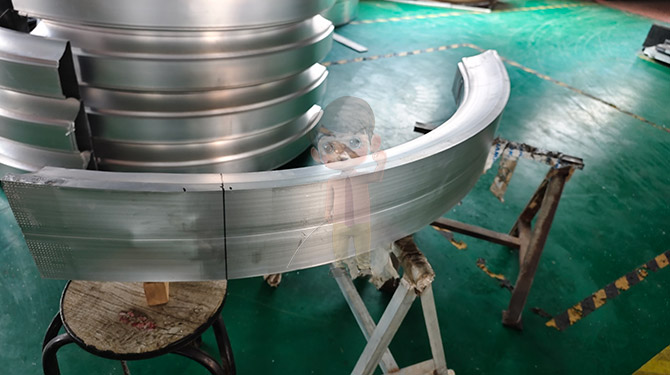Sustainable Approaches to Bending Building Materials
In the construction industry, the bending of building materials plays a crucial role in achieving both functional and aesthetic design goals. However, with the increasing emphasis on sustainability and environmental responsibility, the methods used in bending materials must evolve.
1. The Importance of Sustainable Bending Practices
As the global construction industry faces challenges related to climate change and resource depletion, sustainable practices have become imperative. The bending of building materials, traditionally associated with high energy consumption and waste generation, presents an opportunity for innovation. By adopting sustainable approaches, the industry can reduce its carbon footprint, lower production costs, and promote the use of renewable resources.
2. Eco-Friendly Materials for Bending
One of the key aspects of sustainable bending practices is the choice of materials. Traditional materials like steel and concrete, while strong and durable, have significant environmental impacts in terms of energy consumption during production and transportation. Conversely, the use of eco-friendly materials can greatly enhance sustainability in construction. Some promising alternatives include:
-Bamboo: Known for its rapid growth and high tensile strength, bamboo is a renewable resource that can be bent into various shapes. Its lightweight nature also reduces transportation emissions.
-Recycled Plastics: Incorporating recycled plastics into building materials not only reduces waste but also allows for flexible designs that can be easily bent without compromising structural integrity.
-Engineered Wood Products: Materials such as laminated veneer lumber (LVL) and cross-laminated timber (CLT) can be bent and shaped while maintaining strength. These materials are sourced from sustainably managed forests, making them an eco-friendly option.

3. Innovative Bending Techniques
Advancements in technology have paved the way for innovative bending techniques that enhance sustainability. Some notable methods include:
-Thermal Bending: This process involves applying heat to materials to make them pliable. For instance, wood can be heated and then bent into desired shapes. This method minimizes the need for chemical adhesives and reduces waste, as it utilizes the natural properties of the material.
-Hydraulic Bending: Utilizing hydraulic presses allows for precise control over the bending process, reducing the risk of material failure and waste. This method can be applied to various materials, including metals and composites, with minimal environmental impact.
-Digital Fabrication: The integration of computer-aided design (CAD) and computer numerical control (CNC) in the bending process ensures accuracy and efficiency. Digital fabrication techniques can minimize material waste by optimizing the use of raw materials, leading to more sustainable outcomes.
4. Benefits of Sustainable Bending Practices
Adopting sustainable approaches to bending building materials offers numerous benefits:
-Reduced Carbon Footprint: By utilizing eco-friendly materials and energy-efficient bending techniques, construction projects can significantly lower their overall carbon emissions.
-Cost Savings: Sustainable practices often lead to reduced material costs and lower energy consumption during production, resulting in long-term savings for construction companies.
-Enhanced Marketability: As sustainability becomes a priority for consumers and regulators, buildings constructed using sustainable materials and methods are more likely to attract interest and investment.
-Regulatory Compliance: Many regions are implementing stricter regulations regarding sustainability in construction. By adopting eco-friendly bending practices, companies can ensure compliance and avoid potential penalties.
5. Case Studies and Real-World Applications
Several projects around the world have successfully implemented sustainable bending practices, showcasing their viability and benefits:
-The Edge, Amsterdam: This innovative office building features curved wooden elements made from sustainably sourced timber. The use of advanced bending techniques not only enhances the building’s aesthetic appeal but also aligns with its sustainability goals.
-Bamboo Houses in Bali: Many architects in Bali are utilizing bamboo for construction, employing thermal bending techniques to create unique structures that blend seamlessly with their natural surroundings. These homes exemplify how sustainable materials can be used creatively.
Sustainable approaches to bending building materials represent a significant advancement in the construction industry. By prioritizing eco-friendly materials and innovative bending techniques, builders can reduce their environmental impact while still achieving functional and aesthetically pleasing designs. As the demand for sustainable construction continues to grow, the integration of these practices will be essential for a more sustainable and responsible built environment. Embracing these changes not only benefits the planet but also sets a precedent for future generations in the architecture and construction fields.
21
2025-06
Number of visitors:1
HOT NEWS
-
Reducing the rebound error of car bumper bending enhances the stability of mass production.
2025-12-17
-
High-precision bending processing service: Automated bending process
2025-12-08
-
High-Accuracy Curve Forming: Achieving Consistent Bends in Aluminum, Steel, and Alloy Materials
2025-11-27
-
Advanced CNC Tube Bending Technology: Achieving Consistent and Reliable Precision in Complex Shapes
2025-11-17




 English
English Chinese
Chinese Japan
Japan German
German

 LIST
LIST
